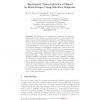Free Online Productivity Tools
i2Speak
i2Symbol
i2OCR
iTex2Img
iWeb2Print
iWeb2Shot
i2Type
iPdf2Split
iPdf2Merge
i2Bopomofo
i2Arabic
i2Style
i2Image
i2PDF
iLatex2Rtf
Sci2ools
92
Voted
MICCAI
2009
Springer
2009
Springer
Topological Characterization of Signal in Brain Images Using Min-Max Diagrams
Abstract. We present a novel computational framework for characterizing signal in brain images via nonlinear pairing of critical values of the signal. Among the astronomically large number of different pairings possible, we show that representations derived from specific pairing schemes provide concise representations of the image. This procedure yields a "min-max diagram" of the image data. The representation turns out to be especially powerful in discriminating image scans obtained from different clinical populations, and directly opens the door to applications in a variety of learning and inference problems in biomedical imaging. It is noticed that this strategy significantly departs from the standard image analysis paradigm ? where the `mean' signal is used to characterize an ensemble of images. This offers robustness to noise in subsequent statistical analyses, for example; however, the attenuation of the signal content due to averaging makes it rather difficult to ...
Cortical Thickness Measures | Image Analysis Paradigm | Medical Imaging | MICCAI 2009 | Specific Pairing Schemes |
| Added | 06 Nov 2009 |
| Updated | 15 Nov 2009 |
| Type | Conference |
| Year | 2009 |
| Where | MICCAI |
| Authors | Moo K. Chung, Vikas Singh, Peter T. Kim, Kim M. Dalton, Richard J. Davidson |
Comments (0)

